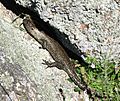Cunningham's spiny-tailed skink facts for kids
Quick facts for kids Cunningham's skink |
|
|---|---|
 |
|
| Cunningham's spiny-tailed skink basking in the sunlight | |
| Conservation status | |
| Scientific classification | |
| Genus: |
Egernia
|
| Species: |
cunninghami
|
| Synonyms | |
|
|
The Cunningham's spiny-tailed skink or Cunningham's skink (Egernia cunninghami) is a type of large skink. Skinks are lizards that belong to the family called Scincidae. These interesting lizards live in southeastern Australia.
Contents
What's in a Name?
The name cunninghami and the common name, Cunningham's spiny-tailed skink, honor a person. They are named after Allan Cunningham. He was an English botanist and explorer.
What Does It Look Like?
This skink can grow quite long, up to 40 cm (about 16 inches). This measurement includes its tail. Sometimes, people might confuse it with blue-tongued lizards.
Cunningham's spiny-tailed skink has special scales. Each scale has a raised part, like a small ridge. This makes the skink look a bit spiny. Its color can change a lot. It might be dark brown or black. It can also have blotchy patches, speckles, or thin bands.
Where Does It Live?
These skinks like to live together in groups. They often find homes in rocky areas. You can find them in cracks in rocks or inside hollow logs.
What Does It Eat?
Cunningham's spiny-tailed skink is active during the day. It eats both plants and animals. This means it is an omnivore. Its diet includes insects, flowers, berries, fungi, leaves, and young plant shoots.
Is It Endangered?
Scientists are studying a group of these skinks. This group lives in the southern Mount Lofty Ranges in South Australia. This specific group is considered vulnerable. This means they are at risk.
Their homes are spread out and separated. This makes it harder for them to find mates and new places to live. Sadly, at least one of these groups has completely disappeared. However, the skink is more common in other suitable places along Australia's southeastern coast.
How Do They Have Babies?
Like some other reptiles, Cunningham's spiny-tailed skinks give birth to live young. This is called viviparous. They do not lay eggs. A mother skink can have six or more babies in one litter.
Why Do They Avoid Mating with Relatives?
When their homes are broken up, it can affect animal groups. For example, it can make it harder for them to avoid mating with close relatives. Mating with close relatives can lead to weaker offspring.
Scientists studied these skinks in areas where their homes were changed. Even with these changes, the skinks tried to avoid mating with close family members. They chose mates who were not closely related. This helps keep their babies healthy and strong.
Gallery
-
Cunningham's spiny-tailed skink in southern Australian Capital Territory.
-
Three E. cunninghami, Cabbage Bay, near Sydney, New South Wales.
See also
 In Spanish: Egernia cunninghami para niños
In Spanish: Egernia cunninghami para niños






